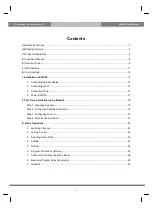
HX500E
Page 24
11. VHF MARINE CHANNEL ASSIGNMENTS
Tables on the following pages list the VHF Marine Channel assignments for
U.S.A. and International use. Below are listed some data about the charts.
1. VTS. Where indicated, these channels are part of the U.S. Coast Guard’s
V
essel
T
raffic
S
ystem.
2. Alpha channel numbers, that is, channel numbers followed by the letter A
(such as Channel 07
A
) are
simplex
channels on the U.S.A. or Canadian
channel assignments whose counterparts in the International assignments
are
duplex
channels. International channels do not use “alpha” num-
bers. If you call the Coast Guard on Channel 16, they will sometimes ask
you to “
go to channel 22 Alpha
.” This is a channel assigned to U.S.A,
and Canadian Coast Guards for handling distress and other calls. If your
radio is set for
International
operation you will go to Channel 22 instead
of 22
A
, and will not be able to communicate with the Coast Guard. To use
Channel 22
A
, your radio must be set for
USA
or
Canada
operation, us-
ing the USA/CAN/INTL channel selection procedure described on page
28 of this manual. Channel 22 (without an “A”) is an
International
duplex
channel for port operations. The
HX500E
displays an “A” adjacent to the
channel number on all “Alpha” channels, unlike some other models that
may not indicate the “A” even though they may be set to the correct
frequency.
3. Bridge-to-Bridge channels (for example, Channel 13) are for use by bridge
operators on inter-coastal waterways and rivers. It is also used by marine
vessels in the vicinity of these bridges for navigation and for communi-
cating with the bridge operators. Note that a limit of 1 Watt is specified for
these channels.
4. The
S/D
column on the chart indicates either S (simplex) or D (duplex).
Simplex
means transmitting and receiving on the same frequency. Only
one party at a time can talk, unlike a telephone. Be sure to say “
over
” and
release your microphone push-to-talk switch at the end of each transmis-
sion.
Duplex
operation involves the use of one frequency for transmitting
and a separate frequency for receiving. On channels specified as duplex
on the charts, correct mode of operation is established automatically by
your radio when you select a channel; you cannot change the mode. And
you still must release the push-to-talk switch after each transmission in
order to listen to the radio.
5. Channels normally used by recreational boaters are those that include











































